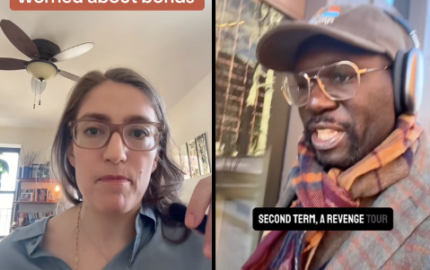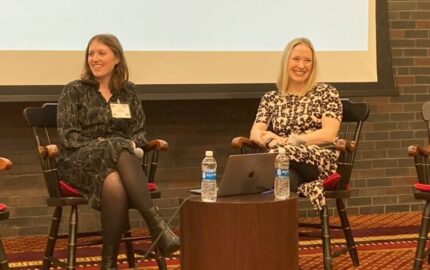
The Moth began in New York in 1997 in the living room of George Dawes Green, who was originally from St. Simons Island, off the coast of Georgia. When he lived there he would meet on his friend Wanda’s porch to tell stories. There was a hole in the screen of the porch, where the moths, drawn to the light, would get in and get stuck. They began to call themselves “the Moths.”
When George moved to New York, he discovered that no one told stories. Everyone stood around at cocktail parties in black turtlenecks trying to sound clever. He said, “I don’t have a porch, but I do have a living room.” He hosted a few nights of stories there, but very quickly so many people showed up that he outgrew his living room. The event went to bars, backrooms, and eventually theaters. We’ve sold out every show we’ve held.
How is it different today?
We deliberately try to keep it relatively intimate while trying to meet the demands of all the people who want to see the shows. We’ve founded all these other programs as a way to include more people. We’re currently running competitive StorySLAMs in New York, Chicago, LA, and Detroit, and we’re moving on to other places around the country. So that’s a way that anyone can sign up and be involved.
Slams have become tremendously popular. We’ve gone from once a month to four times a month in New York, and we have to turn away as many as 100 people at every slam. There’s a real hunger for storytelling in the community.
We’ve also had a desire to reach people who se stories need to be heard, people who wouldn’t come to us on their own. We have this community outreach where we work with kids—mostly high school-age kids. And then we work with adults in rehab programs and people transitioning out of homelessness or prison.
What has your role been in it?
I’m the executive and creative director. I originally started with the Moth community outreach program, which I was hired to start back in 2000. I also produced the Moth Mainstage back when we operated out of an apartment.
Are all Moth stories true, or are some invented?
The concept is that people tell true stories. We don’t fact-check, because our mission is not a documentary one. It’s not a journalistic approach. What we’re interested in is a different kind of emotional truth.
For the Moth Mainstage, we work with every single person who appears—whether it’s an astronaut, a cop, a retired pickpocket, a Pulitzer prize winner, or an Academy Award winner. For all of them, it’s a departure of some kind. Most of our storytellers have never put together a narrative before. It holds a different challenge for every single one of them.
Storytellers have to stand up with no script, no Power Point, no music. There’s nothing to hide behind. They’re not communicating material on which they’re experts; they’re telling something personal. Actors, for instance, may be used to standing on stage but not as themselves. It’s a scary and exhilarating process.
We help them share personal stories. And a huge part of the process is helping them find the core truth of the story—why they want to tell it. So it moves from being an anecdote to a real story. But it’s not like This American Life, or one of the more documentary programs, where every part of what’s said gets verified.
Who are some of the most famous Moth performers?
Salman Rushdie, Sam Shepard, George Plimpton, Spalding Gray, Annie Proulx—there are a lot.
Has anyone who was a complete unknown ever killed?
There was one event held to celebrate the 25th anniversary of PS122, this performance space in New York. To celebrate, we had both George Plimpton and Spalding Gray there. But the person who completely stole the show was the woman who had been PS122’s stage manager for the last 20 years.
We’ve had many people who have made their name doing the Moth. These days StorySLAM is where unknowns can build their community. Participants are often not that good at first. But the persistent ones come again and again and learn from their mistakes.
Instead of the one big event that happened to someone famous—“the time I walked on the moon”—slam storytellers have to turn a small everyday event into a story. What’s special about the slam is that people take a first date or a camping trip and find a way to tell it in a compelling form that becomes engaging for the audience. A lot have gone on to get book and movie deals.
I’ve heard Moth crowds are really responsive. What kinds of moments in the stories do they tend to respond to?
I think it’s the honesty in it that they respond to. It establishes a rapport with the audience and performer. Here the storyteller steps out without props or scripts or endless rehearsal. We do rehearse some, but not relentlessly.
The one demand is that you are willing to step out there and be completely present with the audience and say, “I am not performing something to you, for you, or at you, I’m sharing something with you in this moment that is true for me.” When people do that, the audience becomes so invested in them. The audience understands how inherently terrifying it is. Most people say it feels like they’re standing naked.
I think that this is the reason—this is what people respond to. And they say, “Oh my God. I will come to everything you do for the rest of my life.”
In comedy clubs, for instance, people kind of sit there, saying, “Make me laugh.” You have to win them over. There’s a hostility that has to be broken down.
But people at the Moth step on stage, and the audience sends the love out right away. There’s a dialogue between the audience and the storyteller—it’s an intense experience for both parties. If the storyteller dares to be honest, even if they’re two-thirds of the way into the story and forget where they’re going next, the audience will forgive it. What they will not forgive is anything inauthentic. It’s like baking with yeast, a very delicate process. If the storyteller is up there going through the motions or doing something that feels like shtick or too rehearsed, the audience will not respond as well.
How do written stories and spoken stories differ? Are there things that work in person that wouldn’t on the page and vice-versa?
There’s a different kind of economy. When people are reading at their own pace at home, you can take many more detours. You can have long-winded descriptions and you can have many narrative lines going at the same time. If they forget who Oscar is, they can look back a few pages and check.
In real time, you can’t go back. If you confuse them, they take a few minutes to reorient, and then they’ve lost that time before you get them back. They’ve missed part of the story.
There’s a tight economy of moving the basic plotline forward and sticking to that, being very clear on the core theme of the story. That’s the work we do, to help them find that core.
That’s why many writers like doing the Moth. Even when they’re completely overextended, they will call back and say, “You know what, I should really do the Moth, because that will help me figure out what I have to say in this two hundred pages of screenplay I’m stuck with.” Something about having to do it in 10 minutes makes people focus on the core of the story.
On Nieman Storyboard, we look at how stories work across all media. What are the key elements in a good spoken-word story?
When we’re working with storytellers, we ask questions like, “What is the story in one sentence? Or even two words—what are you going from and what are you going to?”
In all forms of writing, you have to have themes. But in writing you can have many more themes. For the Moth, you really do need to have one theme for one story. Your story about going skydiving for your 50th birthday could be any of five stories, depending on what is the deeper story of your life.
The important thing in storytelling is to choose, so you have an organizing principle for your piece and you can give the audience a rope to hang onto.
Very often people discover a different story than they thought they had. There is a kind of a therapeutic element, in that people can’t tell their story until they figure out what it’s about. Sometimes we call someone and say, “You’ve got to tell a story about the time you had to punch a shark in the face to rescue your son.” At other times, we call up an astronaut and talk about his experiences for two hours, only finding out what the real story is near the end.
We often find that if you don’t know how to end it, you don’t know what it’s about yet. There was a woman who was adopted, and her story’s initial ending was how she lived happily ever after. She couldn’t get from the middle to the end, and it was because her ending wasn’t really true. So we said, “Go home and think about it over the weekend.” She came back and said, “I’m so angry. Thanks a lot.”
But with all these mentions of the therapeutic aspects of finding the story, I also want to say that storytelling is more than just the sharing of your personal self. In order for a story to work, it still has to be a compelling, well-crafted narrative. The audience has to feel that the performer is being completely honest while being an artist. The magic in the Moth lies in that balance between the craft and the rawness of the honesty.


